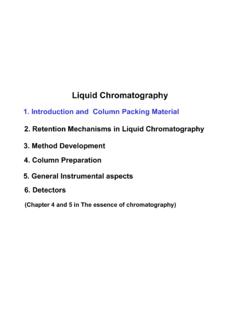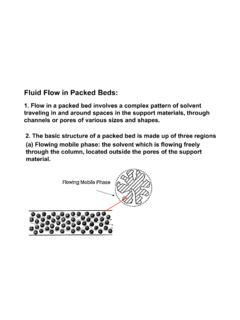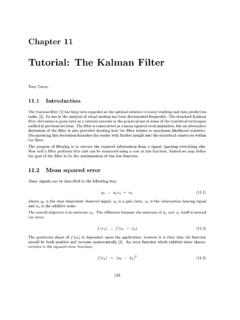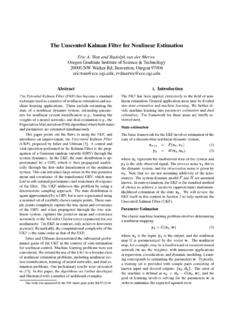Transcription of Diffusion and Fluid Flow - University of Florida
1 What determines Fluid flow? Diffusion and Fluid FlowWhat determines the Diffusion coefficient?What determines the Diffusion coefficient?1. Diffusion : Diffusion refers to the transport of substance against a concentration gradient. Mass transfer: movement of mass from one place to anotherDiffusion: movement of mass from region of high concentration to lowconcentration. J = -D(Flux of mass, D: Diffusion coefficient)2. Diffusion is an important process in chromatography in determiningthe mass transfer and band-broadeningdNdz S>03. Einstein Diffusion equation:td= d2/(2D)Where, td= average time required to diffuse a distance dd = distance of travel14. The change in distribution of a band of chromatography with time due to Diffusion can be described as a function of distance and time by a Gaussian and band broadeningWhere, Cx= concentration of A at position x and time tCx= C0(2 Dt-(x2/4Dt)) e1C0= concentration of A at position at x = 0 and time t = 0t = timex = distance from A s starting pointD = Diffusion coefficient for A2 What determines the Diffusion coefficient?
2 A. Diffusion in an open system1. The value of D may vary over many orders of magnitude depending on the solute, solvent and temperature of the system of interest2. Diffusion in gases:(a) For solute in gases, Diffusion is a rapid process due to the lowdensity of the solvent.(b) Typical value of D for solute in gas rang from 1 to cm2/sec at 1 atm pressure.(c) Examples of Diffusion coefficients for various solutes in gases:Solute Solvent T (k)DAB(cm2/sec) (d) The value of the Diffusion coefficient for a solute A in a gas B depends on the temperature, pressure, and molecular weight or sizes of the solute and D can be estimated by using the following = x [(sum vi)A1/2+ (sum vi)B1/2] ( )MWA1 MWB1 Where: T = absolute temperatureP = absolute pressureMWx: molecular weight for A and B(sum vi)x = sum of the Diffusion volumes of all atoms in the molecule ( , a measure of A and B s size)Question: The Diffusion coefficient of water molecules in hydrogen (the carrier gas) at 307 k and 1 atm is 1 cm2/sec.
3 What is the average time that the water molecules to travel a distance of 1 mm in the gas chromatographic system? Assuming there no interactions between water and the Diffusion in liquids:(a) Diffusion in liquids is much slower that in gases due to the high density of the solvent and the greater chance for interactions between the solute and solvent.(b) Typical values of D for solute in liquid are 10-5to 10-7cm2/sec(c) The value of D for various solutes (A) in liquid solvent (B) are shownDiffusion in liquids at 20 oCSolute Solvent DAB(cm2/sec*10-5) (d) The value of D for a solute in a liquid depends on temperature, viscosity of liquid and size and shape of solute. For spherical molecule A in a liquid B, D is given by stokes-Einstein equation:DAB= kT/(6 BrA)k = Boltzmann constant; T = absolute temperature B = viscosity of the solvent, rA= radius of the spherical molecule 5B.
4 Diffusion in a packed bed1. Diffusion in a bed containing a porous support is typically slower than Diffusion in an open system. This is created by tortuosity of the flow paths and bottleneck Tortuosity refers to the decease in a solute s rate of Diffusion due to the presence of wandering paths in the packed bed, whether within the pores of the support or around the support particles. The presence of such paths results in a slower rate of travel for the solute through the medium3. The bottleneck problem refers to the decreases in the rate of solute Diffusion due to the presence of ink bottle or narrow channels in the support. 6 What determines Fluid flow?What determines the Diffusion coefficient?7 What determines Fluid flow?A definition: 1. Fluid flow, or convective mass transfer, refers to the transportof solute through a system as they are being carried by the solvent.
5 2. Fluid flow is an essential part of chromatographic Measures of Fluid flow:1. Flowrate (F): the volume of the solvent traveling through the column perunit time (units: mL/min, ).2. Linear velocity (u): The distance of a solute or solvent travels in the column per unit time (units: cm/sec, cm/min).3. The relationship between u and F is shown below:(a) for mobile phase flowing through the column:ump= F (L/Vm)= L/tm Vm= column void volume; L = column length; and tm= column void time8(b) for a solute flowing through the column phase flowing through the column usolute= F(L/VR)= L/tRusolute= solute s linear velocity through the column, tR = solute s the retention time, VR= solute s retention volume. C. Fluid flow in open tubes:1. Flow of a solvent through a circular tube can be one of three types(a) plug flow, (b) turbulent flow, or (c) laminar flow.
6 2. The type of flow expected in a given system can be determined by using the Reynolds number (Re): the ratio of inertial force and viscous forceRe = u dp/ Where: = solvent density (g/cm3)u = solvent linear velocity (cm/sec)dp= tube diameter (cm) = solvent viscosity (poise)Newtonian Fluid : Inertial force and viscous force93. Types of Fluid Flow:(a) Plug or ideal Flow (Re= infinity)i. This is the best type of flow in theory since all solute travel at the same speed through the flow-stream. As a result, they all reach the end of the tube at the same time and no addition band-broadening However, this type of flow is not obtainable in practice and is used only as a model system to help understand factors that affect Fluid force and viscous forceRe = u dp/ 10(b) Turbulent flow (Re> 2100)Inertial force and viscous force(i) This is the best type of Fluid flow obtainable in practice.
7 (ii) Although there is some difference in the rate of travel for molecule in different parts of the flow-stream, the turbulent core has random eddies and currents that mix molecules from different parts of flow-stream. This helps to minimize differences in the rate of travels of molecules in the capillary, and helps prevent band-broadening. Re = u dp/ 11(c) Laminar (parabolic) Flow (Re< 2100)(i) This is the most common type of Fluid flow and is that which is usually seen in chromatography.(ii) Fluid is this type of flow has a well-characterized profile in the tube that can described by a parabolic curve. The equation relating the speed at with a molecule travels to its position in the flowstream is as umax (1-x2/r2)Where: r = radius of tube; x = distance of the molecule from the center of tube; umax= Maximum linear velocity of a solute in the flow profile; ux = linear velocity of a molecule at distance = u dp/ Inertial force and viscous force12(iii) Note in this equation that the maximum rate of flow for a molecule is at the center of tube, where x = 0 and ux= umax(iv) Since molecules at different location of the flowstream travel through the tube at different rates, some arrive at the end of the tube before others, producing band-broadening.
8 (v) The average linear velocity of a molecule in a laminar flow profile is give by the equation:uavg= umax/2 Where uavg = average linear velocity(vi) The maximum and average linear velocities for laminar flow in an open tube can be related to the length and pressure drop across the tube by the Hagen-Poiseuille Equation umax= P r2/(4 L)uavg= P r2/(8 L)Where: P = pressure drop across the tube ( P at inlet P at the outlet) = solvent viscosity; L = tube length; r = tube radius1312. Determine what type of flow is present in each of the following systems. The density and viscosity of water at 20oC are g/cm3and poise, respectively, and the density and viscosity of nitrogen at 100 oC and 1 atm are g/cm3 and poise, respectively.(1) A LC system with a 2 m X 50 micron ID open tube using water as the mobile phase, flowing at mL/min and at 20 oC.
9 (2) A GC system with a 25 m X 250 micron ID open tube using nitrogen as the mobile phase at a flow-rate of 2 mL/min at 2mL/min at 1 atm and 100 An open tubular column has a diameter of 207 m and the thickness of the stationary phase on the inner wall is m. Unretained solute pass through in 63 s and a particular solute emerges in 433 s. Find the partition coefficient for this solute and find the fraction of time spent in the stationary In a typical liquid, molecules jump randomly to one side or another about 1010times per second in steps of nm length. Calculate the Diffusion coefficient for such A mixture of benzene, toluene, and air was injected in to an open tubular GC column that has an inner diameter of 250 m and is coated on the inside with a layer of stationary phase m thick. Air gave a sharp peak spike in 42 s, whereas benzene required 251 s and toluene was eluted in 333 s.
10 (1) Find the adjusted retention time and capacity factor for each solute. (2) Estimate the distribution coefficient (K = Cs/Cm) for benzene and toluene between stationary and mobile phases. (3) State what fraction of time benzene and toluene spend in the mobile











